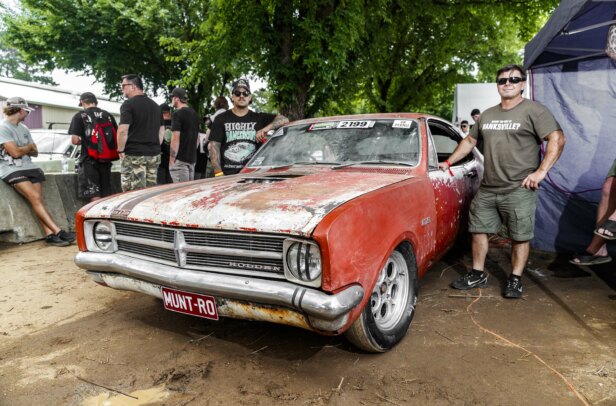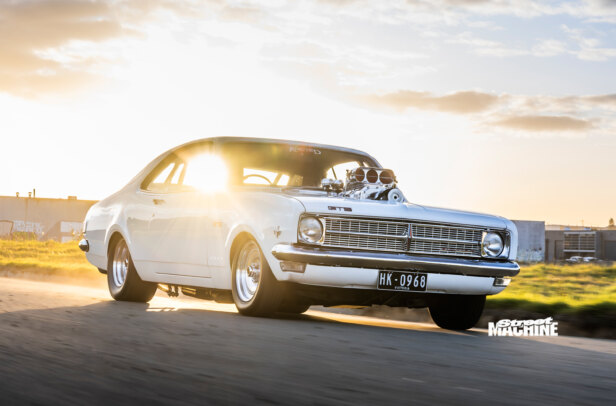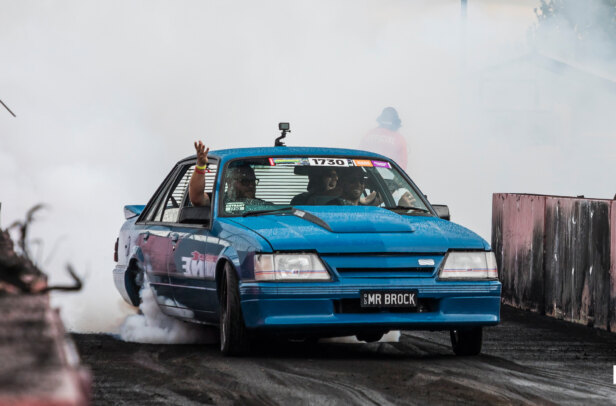Street machines don’t get much better than Brian Willis’s Summernats 7 Grand Champion Monaro. They come tougher and meaner but only a very few are in the same ballpark when it comes to overall quality of workmanship and visual impact. Just ask the Summernats judges. In fact, ask anyone who has studied the car. It’s magnificent – and, importantly, it’s innovative – in just about every respect.
For many people, Brian Willis came out of nowhere to grab the Summernats crown, then clean up at Melbourne’s Hot Rod show. In fact, Brian’s been around a long time. So have the people who helped him build this car, most notably master car-builder and sometime street machine judge Owen Webb.
First published in the Jul/Aug 1994 issue of Street Machine

Brian first surfaced in Street Machine back in 1988 with a yellow big-block HK Monaro. He says he bought the car already built up by a guy named Tony Baxter, in Goulburn. The idea was to use it as a testbed for the HK that’s now in your face. It was smart thinking. So was getting Owen Webb involved in the car Brian eventually wanted to build.
“I’ve known Owen since I left school,” Brian says. “I took my first car to him, an old HD Prem, to get some rust cut out of the doors. I’ll admit that he was a bit dearer than the other quotes, but he insisted he’d do it properly, and he did. I kept going back to his shop to hassle him about how to build cars, and I ended up getting to know him.”

That landline to one of Australia’s most gifted spray painters and car builders was definitely a foot in the door when the time came to build up the sad $900 HK he’d bought years before and stowed in his garage. According to Owen, he got involved in Brian’s project because he’d always wanted to build a Summernats Grand Champion car and he believed Brian had the all-important perseverance to make it happen.
Owen did the superlative paint and graphics – including the awesome work on the undercarriage – straightened the body and provided much of the inspiration for the entire project. He’s the man responsible for the ‘Innovator not imitator’ insignia on the glovebox lid.
Owen brought back from America ideas for the trim and got another sometime Summernats judge, Stuart Davis, involved in the Monaro’s leading-edge interior.



The project has been a long one, partly interrupted when Brian decided to condemn his house and rebuild it after his first child arrived, partly because he was busy adding a joinery trade qualification to the boilermaker’s certificate he already held. In fact, according to Brian, the car could’ve made Summernats 5 if things hadn’t got in the way. As it was, it spent almost two years parked on a rotisserie with the family furniture neatly stored underneath.
Bought from the classifieds, the Munro was unregistered, standard, and white with a blue interior. The panels were relatively good and even the floor was okay. Not fantastic, mind, just okay. Through the magic of magazines, we’ll skip all the build details and concentrate on the major ingredients of this landmark car. Besides, Brian reckons he’d do things differently next time – “I’d have spent three years planning the car and only two years building it”.

John Cannon’s the man responsible for the tubbed three-quarter chassis and four-link rear end. The 1½in-lowered front stub axles are by Rod Hadfield’s Castlemaine Rod Shop. The tail sits at almost standard height, though Owen Webb’s 15×3½ and 15×15 CenterLines and their Michelin and Mickey Thompson rubber make it look lower. “It doesn’t seem low when you’re in the car,” Brian says. “It’s able to drive over a gutter, which is good.”
The relatively mild 350 is beautifully detailed in an incredibly detailed engine bay. The work of Sydney’s Hume Performance was built with fuel injection in mind, perhaps a late-model Corvette set-up. “We were careful we didn’t go for too big a camshaft because we’d then need an aftermarket fuel-injection system,” says Hume Performance boss Barry Byrt. Big Bazza also organised the 2500rpm-stalled TH400 from Sydney’s Ross Burgess.

The double-hump Fuellie heads went to Benny Gatt of drag racing and Superflow Heads fame. Benny says he didn’t go for cyclonic flow rates. “We ported them, did a three-angle valve job, put in a set of Competition Cams springs and screw-in studs, match-ported them to the manifold and flowed them for around 450 horsepower,” he explains. “Nothing really radical. The owner wanted reliability, and that’s what he got.”
The engine bay itself is a combination of some innovative work from Brian and milling work by his former workmate turned good mate, Andrew ‘Chuck’ Key. The naked firewall is Brian’s handiwork. It’s made from a clean sheet of plate and the disappearance of at least some of the usual wall-hangings can be explained by the presence of an XB brake booster in the glovebox. Would you believe the wiper motor’s hidden beneath the scuttle panel?

Brian also did most of the undercarriage tinwork, all the undercarriage fill work – readying the car for Hi-Fill – and a lot of exterior prep. The car was in Owen’s garage for 12 months while he did the body. “It involved more work than the paint,” Owen says. “There’s not a seam or spot weld anywhere on that car, even behind the bumper bars, behind the tail-lights, anywhere. Every seam is welded with steel.”
As you’d expect, the paintwork is simply the best. The paint’s ICI Dulux Autocolor Cobra, a special mix of Lucky Strike Green, fairly heavy on the pearl. The custom graphics were drawn and computer-cut to Owen’s specifications by Paul Graham of Rabbit Signs, then painstakingly applied by Owen.

The graphically illustrated and cobra-coated undercart copped two coats of clear. “I cut and buffed every inch of the car, including inside the doors,” Owen says. “The car goes into the graphics categories for judging but I think the rest of the paint is one of its strongest features.”
Brian’s put on hold his work towards a builder’s licence and plans to show the car everywhere, or until the money runs out. After its Summernats triumph, the Monaro’s trip to the Melbourne Hot Rod Show netted Top Street Machine, Top Interior, Top Tudor, Top Mural Graphics and a Top 5 berth. Brian’s sure of one thing: he’ll show his masterpiece until it’s time to retire it to the street. You get a strong feeling he can’t wait.

BRIAN WILLIS
1968 HK MONARO
| MAKIN’ IT MOVE | |
| Type: | 350 Chev |
| Crank: Stock | 350 Chev |
| Cam: | Hydraulics |
| Heads: | Fuellie Double Hump |
| Carbs: | 650 Holley |
| Exhaust: | Headers |
| UNDERNEATH | |
| Shocks: | Pedders (f), coil-overs (r) |
| springs: | Pedders (f), Koni adjustable (r) |
| ROLLIN’ | |
| Wheels: | CenterLines, 15×31/2 (f), 15×15 (r) |
| Tyres: | Michelin (f), Mickey Thompson (r) |



Comments